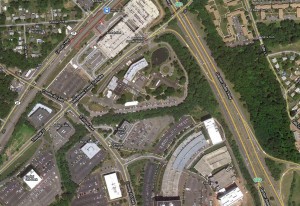New Jersey Future Blog
Metropark, and the Limits of Brookings’ Transit Accessibility Study
June 13th, 2011 by Tim Evans

Despite being adjacent to one of the state's busiest rail stations, office buildings at Metropark are designed to accommodate drivers, not transit riders.
When the Brookings Institution released its recent report on jobs and public transportation, “Missed Opportunity: Transit and Jobs in Metropolitan America,” it was difficult to extract any succinct new lesson from it. This was partly because New Jersey Future had already done its own report of where jobs have been locating with respect to the transit network. But the Brookings results also seemed counterintuitive: Modesto, Fresno and Tucson have a higher percentage of transit-accessible jobs than New York or Philadelphia? If that’s the case, why don’t more people ride transit to work in these smaller metro areas?
In Brookings’ defense, the results are more logical than they may seem at first, considering that the study was done at the level of the entire metropolitan area, not just the principal city, and considering that Brookings looked at bus as well as rail transit. The New York metro area covers most of northern and central New Jersey and includes places like Parsippany, Bridgewater, Piscataway, Metropark and every other locus of highway-oriented office development in the northern half of the state. Office parks are not generally what anyone would call “transit-accessible,” so it’s easy to see how Manhattan’s substantial transit advantage gets eroded by the inclusion of all the car-oriented “job sprawl” in the surrounding counties. New York City may be bursting with transit-accessible employment, but the rest of its metro area incorporates a lot of car-dependent territory.
At the same time, though, Metropark illustrates the study’s definitional limitations. Its cluster of office buildings actually is located immediately adjacent to a commuter rail station on the Northeast Corridor, so the jobs at Metropark would be counted as transit-accessible by Brookings’ methodology—even though most people are driving to them and even though the jobs are located there because of their proximity to major highways, not their proximity to the rail line. So the methodology, while it correctly assesses how many jobs are transit-accessible in theory, fails to consider other factors (free parking, pedestrian amenities, ease of driving) that influence whether people will actually ride transit to a particular location.
So while Brookings may be correctly measuring how many jobs are hypothetically within a 90-minute transit ride of the typical metropolitan commuter, it does not logically follow that steering jobs to a location that is technically accessible via the transit network is necessarily going to result in an increase in transit commuting—which is, after all, the goal transportation planners typically have in mind. That logical implication doesn’t really begin to take effect until a metro area has reached a certain critical mass, where major highway arteries approach capacity and transit (in particular, transit that doesn’t have to share the road with personal vehicles) starts to look like a viable alternative. The metro areas that top Brookings’ list generally have a long way to go before they’ve hit this critical mass; most of them have fairly extensive transit systems (mostly bus) that no one uses because they can get to work faster by driving. They score high on Brookings’ measure of accessibility, but this doesn’t translate into actual transit ridership.
The redoubtable Nate Silver at FiveThirtyEight delves into this disparity between Brookings’ measure of transit accessibility and actual transit commuting rates in more quantitative detail and reaches the same conclusion: Having a large number of jobs near transit will not induce people to ride transit to work unless it is time-competitive with driving, which is generally not the case in smaller metro areas:
“Ironically, the cities that ranked highly in the Brookings ratings may have done so precisely because they are good cities for drivers. Of the people who took public transit to work in their top 10 cities, 91 percent did so by bus, according to data from the American Community Survey. The thing about buses is that, unless they have special right-of-way (as they do in some cities like Pittsburgh and Seattle), they by definition can’t be faster than passenger cars since they follow the same roads, but do so with more stops and with other inconveniences (like walking and waiting time) to the commuter.
Cities that have roads that are relatively free of congestion — and the midsize cities of the western United States that top the Brookings list qualify since they were designed with cars in mind — will provide for fast commutes by bus in an absolute sense. But the routes will nevertheless be slower than they would be by private automobile, so not very many people will use them. A study that evaluated public transit through the paradigm of access to public transit, like the Brookings study did, would not catch the distinction, but one that instead focused on the choices available to commuters would. You could spend billions of dollars expanding the light rail system in Buffalo and build something completely state-of-the-art — but because Buffalo already offers extremely short commute times (because of its population loss), it would be a waste of resources and nobody would use it.”
Steering jobs to transit-accessible locations is a laudable goal, but it will not necessarily result in higher rates of transit commuting unless the alternative—specifically, driving—is sufficiently inconvenient. The metro areas with the highest rates of actual transit commuting (as enumerated in the FiveThirtyEight critique, which is worth a read in full) are exactly these kinds of places: large, mature metro areas with congested highways and with rail transit networks feeding into an established (though perhaps no longer dominant) center. The argument laid out in the New Jersey Future report, Getting to Work, about steering jobs to (rail) transit nodes is pertinent precisely because the New York and Philadelphia metropolitan areas, which together encompass 93 percent of New Jersey’s population, fit this description.
The Brookings report thus provides a valuable tool for assessing the reach of a metropolitan area’s transit network, but additional information, and user discernment, is required if the task is to identify the best locations on the transit network at which to foster employment clusters so as to increase commuting by transit.
[Note: Brookings responds to Nate Silver’s critique here.]
















